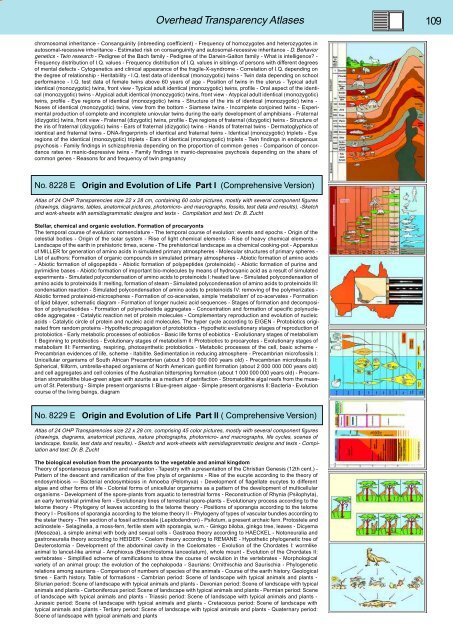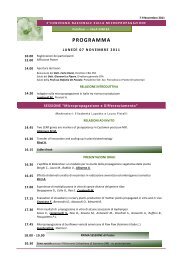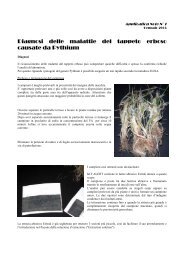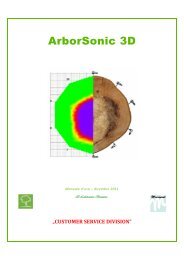BIOLOGY - microscopia.info
BIOLOGY - microscopia.info
BIOLOGY - microscopia.info
Create successful ePaper yourself
Turn your PDF publications into a flip-book with our unique Google optimized e-Paper software.
Overhead Transparency Atlases<br />
109<br />
chromosomal inheritance - Consanguinity (inbreeding coefficient) - Frequency of homozygotes and heterozygotes in<br />
autosomal-recessive inheritance - Estimated risk on consanguinity and autosomal-recessive inheritance - D. Behavior<br />
genetics - Twin research - Pedigree of the Bach family - Pedigree of the Darwin-Galton family - What is intelligence? -<br />
Frequency distribution of I.Q. values - Frequency distribution of I.Q. values in siblings of persons with different degrees<br />
of mental defects - Cytogenetics and clinical appearance of the fragile-X-syndrome - Correlation of I.Q. depending on<br />
the degree of relationship - Heritability - I.Q. test data of identical (monozygotic) twins - Twin data depending on school<br />
performance - I.Q. test data of female twins above 60 years of age - Position of twins in the uterus - Typical adult<br />
identical (monozygotic) twins, front view - Typical adult identical (monozygotic) twins, profile - Oral aspect of the identical<br />
(monozygotic) twins - Atypical adult identical (monozygotic) twins, front view - Atypical adult identical (monozygotic)<br />
twins, profile - Eye regions of identical (monozygotic) twins - Structure of the iris of identical (monozygotic) twins -<br />
Noses of identical (monozygotic) twins, view from the bottom - Siamese twins - Incomplete conjoined twins - Experimental<br />
production of complete and incomplete uniovular twins during the early development of amphibians - Fraternal<br />
(dizygotic) twins, front view - Fraternal (dizygotic) twins, profile - Eye regions of fraternal (dizygotic) twins - Structure of<br />
the iris of fraternal (dizygotic) twins - Ears of fraternal (dizygotic) twins - Hands of fraternal twins - Dermatoglyphics of<br />
identical and fraternal twins - DNA-fingerprints of identical and fraternal twins - Identical (monozygotic) triplets - Eye<br />
regions of the identical (monozygotic) triplets - Ears of identical (monozygotic) triplets - Twin findings in endogenous<br />
psychosis - Family findings in schizophrenia depending on the proportion of common genes - Comparison of concordance<br />
rates in manic-depressive twins - Family findings in manic-depressive psychosis depending on the share of<br />
common genes - Reasons for and frequency of twin pregnancy<br />
No. 8228 E Origin and Evolution of Life Part I (Comprehensive Version)<br />
Atlas of 24 OHP Transparencies size 22 x 28 cm, containing 60 color pictures, mostly with several component figures<br />
(drawings, diagrams, tables, anatomical pictures, photomicro- and macrographs, fossils, test data and results). -Sketch<br />
and work-sheets with semidiagrammatic designs and texts - Compilation and text: Dr. B. Zucht<br />
Stellar, chemical and organic evolution. Formation of procaryonts<br />
The temporal course of evolution: nomenclature - The temporal course of evolution: events and epochs - Origin of the<br />
celestial bodies - Origin of the solar system - Rise of light chemical elements - Rise of heavy chemical elements -<br />
Landscape of the earth in prehistoric times, scene - The prehistorical landscape as a chemical cooking-pot - Apparatus<br />
of MILLER for generation of amino acids in simulated primary atmospheres - Molecular structures of primary spheres -<br />
List of authors: Formation of organic compounds in simulated primary atmospheres - Abiotic formation of amino acids<br />
- Abiotic formation of oligopeptids - Abiotic formation of polypeptides (proteinoids) - Abiotic formation of purine and<br />
pyrimidine bases - Abiotic formation of important bio-molecules by means of hydrocyanic acid as a result of simulated<br />
experiments - Simulated polycondensation of amino acids to proteinoids I: heated lave - Simulated polycondensation of<br />
amino acids to proteinoids II: melting, formation of steam - Simulated polycondensation of amino acids to proteinoids III:<br />
condensation reaction - Simulated polycondensation of amino acids to proteinoids IV: removing of the polymerizates -<br />
Abiotic formed proteinoid-microspheres - Formation of co-acervates, simple ‘metabolism’ of co-acervates - Formation<br />
of lipid bilayer, schematic diagram - Formation of longer nucleic acid sequences - Stages of formation and decomposition<br />
of polynucleotides - Formation of polynucleotide aggregates - Concentration and formation of specific polynucleotide<br />
aggregates - Catalytic reaction net of protein molecules - Complementary reproduction and evolution of nucleic<br />
acids - Catalytic circle of protein and nucleic acid molecules. The hyper cycle according to EIGEN - Protobiotics originated<br />
from random proteins - Hypothetic propagation of protobiotics - Hypothetic evolutionary stages of reproduction of<br />
protobiotics - Early metabolic processes of eobiotics - Basic life forms of eobiotics - Evolutionary stages of metabolism<br />
I: Beginning to protobiotics - Evolutionary stages of metabolism II: Protobiotics to procaryotes - Evolutionary stages of<br />
metabolism III: Fermenting, respiring, photosynthetic protobiotics - Metabolic processes of the cell, basic scheme -<br />
Precambrian evidences of life, scheme - Itabitite. Sedimentation in reducing atmosphere - Precambrian microfossils I:<br />
Unicellular organisms of South African Precambrian (about 3 000 000 000 years old) - Precambrian microfossils II:<br />
Spherical, filiform, umbrella-shaped organisms of North American gunflint formation (about 2 000 000 000 years old)<br />
and cell aggregates and cell colonies of the Australian bitterspring formation (about 1 000 000 000 years old) - Precambrian<br />
stromatolithe blue-green algae with azurite as a medium of petrifaction - Stromatolithe algal reefs from the museum<br />
of St. Petersburg - Simple present organisms I: Blue-green algae - Simple present organisms II: Bacteria - Evolution<br />
course of the living beings, diagram<br />
No. 8229 E Origin and Evolution of Life Part II ( Comprehensive Version)<br />
Atlas of 24 OHP Transparencies size 22 x 28 cm, comprising 45 color pictures, mostly with several component figures<br />
(drawings, diagrams, anatomical pictures, nature photographs, photomicro- and macrographs, life cycles, scenes of<br />
landscape, fossils, test data and results). - Sketch and work-sheets with semidiagrammatic designs and texts - Compilation<br />
and text: Dr. B. Zucht<br />
The biological evolution from the procaryonts to the vegetable and animal kingdom<br />
Theory of spontaneous generation and realization - Tapestry with a presentation of the Christian Genesis (12th cent.) -<br />
Pattern of the descent and ramification of the five phyla of organisms - Rise of the eucyte according to the theory of<br />
endosymbiosis — Bacterial endosymbiosis in Amoeba (Pelomyxa) - Development of flagellate eucytes to different<br />
algae and other forms of life - Colonial forms of unicellular organisms as a pattern of the development of multicellular<br />
organisms - Development of the spore-plants from aquatic to terrestrial forms - Reconstruction of Rhynia (Psilophyta),<br />
an early terrestrial primitive fern - Evolutionary lines of terrestrial spore-plants - Evolutionary process according to the<br />
telome theory - Phylogeny of leaves according to the telome theory - Positions of sporangia according to the telome<br />
theory I - Positions of sporangia according to the telome theory II - Phylogeny of types of vascular bundles according to<br />
the stelar theory - Thin section of a fossil actinostele (Lepidodendron) - Psilotum, a present archaic fern. Protostele and<br />
actinostele - Selaginella, a moss-fern, fertile stem with sporangia, w.m. - Ginkgo biloba, ginkgo tree, leaves - Dicyema<br />
(Mesozoa), a simple animal with body and sexual cells - Gastraea theory according to HAECKEL - Notoneuralia and<br />
gastroneuralia theory according to HEIDER - Coelom theory according to REMANE - Hypothetic phylogenetic tree of<br />
Deuterostomia - Development of the abdominal cavity in the Coelomates - Evolution of the Chordates I: wormlike<br />
animal to lancet-like animal - Amphioxus (Branchiostoma lanceolatum), whole mount - Evolution of the Chordates II:<br />
vertebrates - Simplified scheme of ramifications to show the course of evolution in the vertebrates - Morphological<br />
variety of an animal group: the evolution of the cephalopoda - Saurians: Ornithischia and Saurischia - Phylogenetic<br />
relations among saurians - Comparison of numbers of species of the animals - Course of the earth history. Geological<br />
times - Earth history. Table of formations - Cambrian period: Scene of landscape with typical animals and plants -<br />
Silurian period: Scene of landscape with typical animals and plants - Devonian period: Scene of landscape with typical<br />
animals and plants - Carboniferous period: Scene of landscape with typical animals and plants - Permian period: Scene<br />
of landscape with typical animals and plants - Triassic period: Scene of landscape with typical animals and plants -<br />
Jurassic period: Scene of landscape with typical animals and plants - Cretaceous period: Scene of landscape with<br />
typical animals and plants - Tertiary period: Scene of landscape with typical animals and plants - Quaternary period:<br />
Scene of landscape with typical animals and plants







